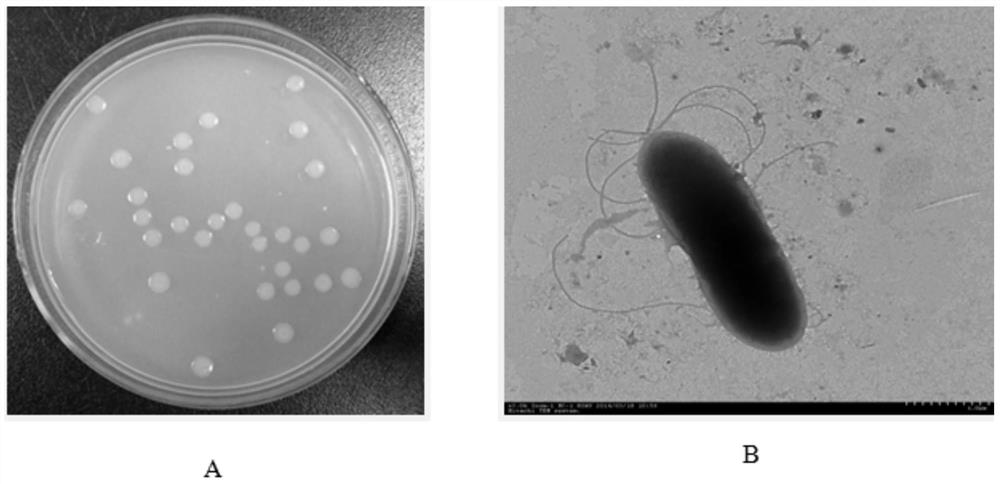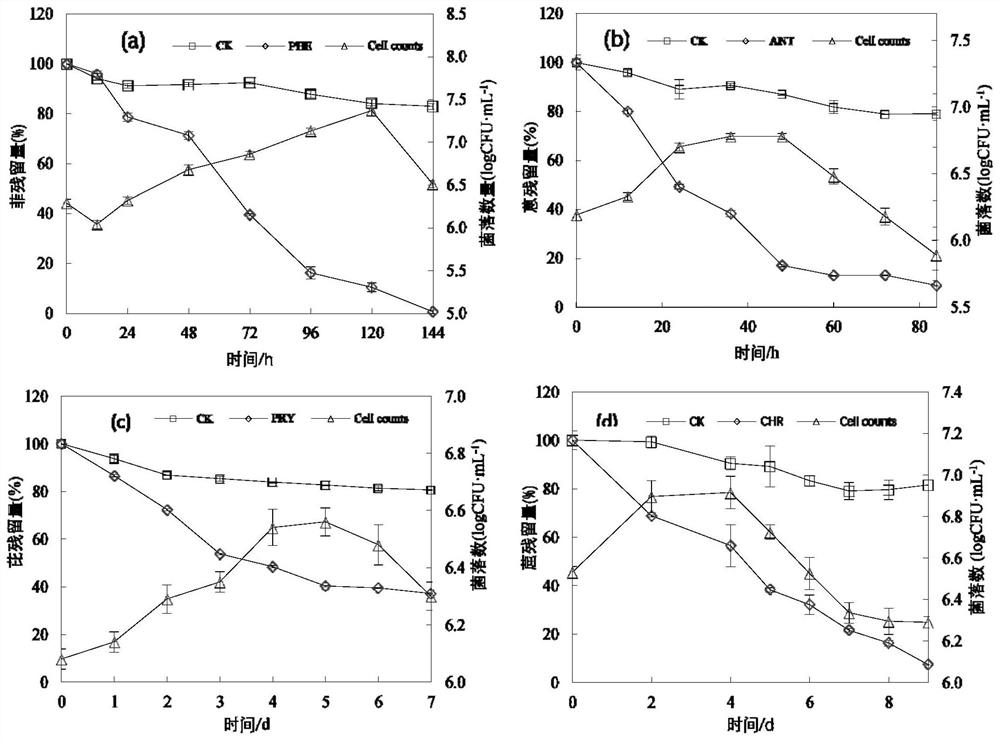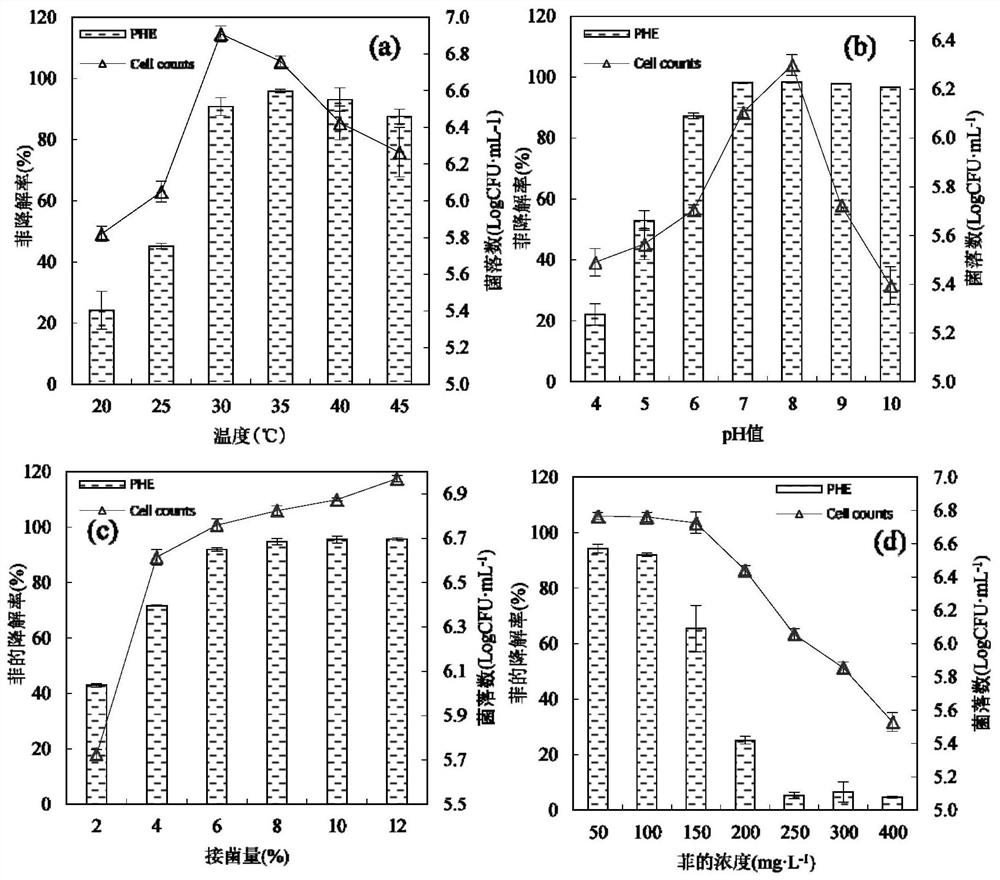A rhizosphere growth-promoting bacterium phe-2 with pahs degrading ability and its application
A rhizosphere growth-promoting bacteria, PHE-2 technology, applied in the direction of bacteria, applications, biocides, etc., can solve the problems of lack of bacteria resources, etc., achieve the effects of convenient use, reduce the risk of phenanthrene pollution, and low production costs
- Summary
- Abstract
- Description
- Claims
- Application Information
AI Technical Summary
Problems solved by technology
Method used
Image
Examples
Embodiment 1
[0031] The isolation and identification of embodiment 1 bacterial strain PHE-2
[0032] Collect samples of Aurantia chinensis near the sewage outlet area of an aromatics factory in Nanjing City, Jiangsu Province, gently remove the soil on the root surface of the plant with a sterilized brush, and then place the root in a centrifuge tube filled with 5 mL of sterilized ultrapure water and shake vigorously 30s, to destroy the bacterial biofilm structure on the root surface to free the bacteria, and the obtained bacterial suspension is used as the bacterial community in the root surface biofilm for future use.
[0033] Add the bacterial suspension to 100 mL of inorganic salt medium at an inoculum size of 2%, and add phenanthrene to 100 mg·L -1As the sole carbon source, at 30°C, 180r·min -1 Cultivate on a shaker for 7 days, transfer to the same medium with 1% inoculum, after three consecutive transfers, serially dilute the enrichment solution, take 10 -4 ~10 -7 Each 0.1mL of t...
Embodiment 2
[0040] The fermentation of embodiment 2 functional bacterial agents
[0041] The process of using strain PHE-2 to produce functional bacterial agent is as follows: slant seed—shake bottle seed solution—seed tank—product (the packaging dosage form is liquid bacterial agent).
[0042] (1) Inoculate the Paenibacillus sp. PHE-2 test tube species with the preservation number CGMCCNO.1.12900 in the fermentation medium, and vibrate to the logarithmic phase;
[0043] (2), above-mentioned cultivated bacterial classification is inoculated into seed tank by 5% inoculum amount, is cultivated to logarithmic phase, obtains seed liquid; The seed liquid is inserted into production tank by 10% inoculum amount for cultivation;
[0044] Wherein, the used fermentation medium of the seed tank and the used fermentation medium of the production tank are the same as the fermentation medium of step (1), and the formula is: peptone 10.0g L -1 , Yeast 5.0g·L -1 , NaCl 10.0g·L -1 , pH 7.0-7.4;
[004...
Embodiment 3
[0047] The biodegradation experiment of bacterial strain PHE-2 to phenanthrene and other PAH in the medium of embodiment 3
[0048] In the inorganic salt culture medium (with embodiment 1), adding initial concentration is 100mg L -1 The phenanthrene (or initial concentration of 100mg L -1 Anthracene or an initial concentration of 50mg L -1 The initial concentration of pyrene or 50mg L -1 of ), insert the functional bacterial agent of embodiment 2 with 5% inoculum, set inoculation inactivated PHE-2 as contrast, 30 ℃ constant temperature shaker 180r min -1 Shake culture. Sampling was taken regularly to detect the growth and degradation of the strain PHE-2 when the above-mentioned various PAHs were used as carbon sources.
[0049] Quantity determination of bacterial strain PHE-2 in the culture medium adopts serial dilution coating plate counting, the determination of the residual phenanthrene content in the culture medium is the same as that in Example 1; the determination ...
PUM
 Login to View More
Login to View More Abstract
Description
Claims
Application Information
 Login to View More
Login to View More - R&D
- Intellectual Property
- Life Sciences
- Materials
- Tech Scout
- Unparalleled Data Quality
- Higher Quality Content
- 60% Fewer Hallucinations
Browse by: Latest US Patents, China's latest patents, Technical Efficacy Thesaurus, Application Domain, Technology Topic, Popular Technical Reports.
© 2025 PatSnap. All rights reserved.Legal|Privacy policy|Modern Slavery Act Transparency Statement|Sitemap|About US| Contact US: help@patsnap.com



